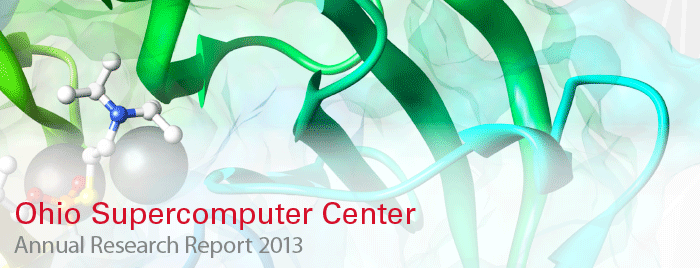A snapshot from simulations developed by Harvey Zambrano of The Ohio State University shows the amorphous silica nanochannel (red and yellow) confining a stream (red and white) of electrolyte-water solution.
Microdevices, such as Labs-On-a-Chip (LOC) systems, are used for biomolecular detection and custom chemical synthesis, among other applications. Over the last decade, LOC systems have evolved from a single channel to systems capable of integrating thousands of reaction vessels, conduits and valves.
As the miniaturization process of LOC devices is reaching the molecular level, nanofluidics, the study of flows in and around structures with at least one dimension between 1-100 nanometers, has become of broader interest. The potential to design and fabricate nanoscale LOC devices requires the rapid and inexpensive handling of minute samples confined in nanoconduits. At the nano-scale, the large surface-to-volume ratio results in deviations from the macroscale fluid behavior, the molecular size matters, the hydration effects are significant and electrostatic and other forces can determine the system behavior.
As an electrolyte solution is confined inside a silica channel, the wall surface becomes charged and will in turn be screened by counterions in a thin layer known as the electric double layer (EDL). If an axial electric field is applied, the motion of the counterions in the EDL will drag the solvent in the direction of the counterion migration, a phenomenon known as electroosmosis. Novel LOC applications employ electroosmotic transport as the driving mechanism to conduct fluids, because electroosmosis generates a uniform bulk flow, which gives higher flow rates and less dispersion than with pressure-driven flow.
Leveraging the resources of the Ohio Supercomputer Center, Zambrano, Ph.D., a postdoctoral researcher at the Computational Micro-Nanofluidics Lab and at the Microsystems and Nanosystems Engineering Lab at The Ohio State University, is evaluating two novel mechanisms to control electroosmotic transport through nanochannels. Zambrano is conducting massively parallel Non-Equilibrium Molecular Dynamics (NEMD) simulations of an electrolyte-water solution. The first mechanism adds traces of divalent ions to an electrolyte solution confined in a nanochannels. The second modifies the EDL by implementing on the channel walls surface counter-charged patches.
“Our objective is to determine if surface-charged patches or traces of divalent ions can be used to control electroosmotic flows in nanodevices,” said Zambrano. “To that end, we’re performing NEMD simulations of 100 nanoseconds (one billionth of a second) on sets of all atoms within a channel, containing a different electrolyte concentration and using a time step of 2 femtoseconds (one quadrillionth of a second). The channel is 34.76 nanometers long and confines 20,500 water molecules.”
Project Lead: Harvey Zambrano, The Ohio State University
Research Title: Controlling the electroosmotic flow in silica nanochannels: An atomistic study
Funding Source: Army Research Office

